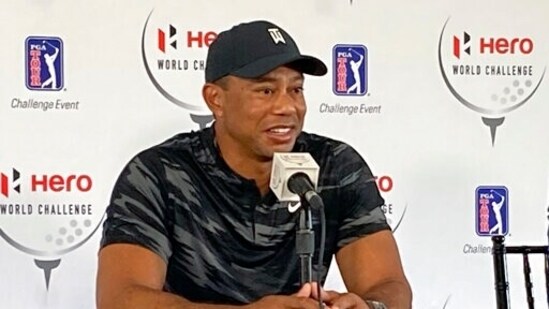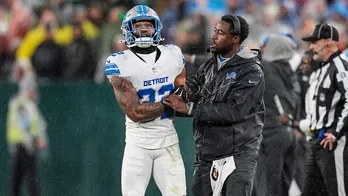Tiger Woods: I'm glad I'm still alive and didn't lose my leg
When he finally came to in the hospital, Tiger Woods's first thought was "do I still have my legs?"  PREMIUM
PREMIUM
Just a few hours ago, he had been in a dramatic and terrifying high-speed crash in Los Angeles, his SUV running over a median on an uphill sweep and rolling down a steep hill.
Woods felt his legs, felt their weight, wriggled his toes.
“I’m like, OK, I didn’t lose it,” he said, speaking to journalists on his first public appearance as the host of the Hero World Challenge on the island of New Providence in The Bahamas.
Lying on the hospital bed after the February 23 crash, Woods said his biggest fear was that he would lose a leg, an option that was very much on the table when he had been wheeled into the operating theatre.
“So when I woke up, I said, ‘I’m alive. I didn’t lose a limb’,” Woods said. “Two crucial positives.”
Nine months on from the road accident that severely damaged the tibia and fibula bones on his right leg, Woods is back on his feet. His mind—and body—isn’t ready for competitive golf yet, but is at a place where he can reflect on the dark (and a few positive) moments of the painfully slow recovery phase.
Asked about the toughest part of his post-crash life, he said, “I think just laying there, laying still.”
Woods did that for three weeks at the Cedars-Sinai Medical Center, followed by another three months on the bed of his home. One of his earliest memories of being on the hospital bed post the accident was seeking a golf club to fiddle around with. This time, though, golf had to wait. Legendary comebacks have defined the career of a man who has been through five knee and five back surgeries and returned to win the trophies as if he’d gone nowhere. This time, though, it was different. It entailed an unprecedented process of making little, gritty improvements, just to be able to stand again.
“First, let’s get the hell out of the wheelchair,” Woods outlined the chronology. “Then, let’s get to the crutches. Let’s get to the boot. Let’s get to where I can throw that boot in the water. Now, OK, you’re on your own, so let’s build up the muscle. Then, can I hit putts? My first few putts, I hit them in the hole but I couldn’t get them out of the hole. So OK, I can’t do that yet.” Hit the pause button there.
Once Woods was allowed to get out of bed, he spent another two months in a wheelchair, a difficult proposition for the 45-year-old who has spent the most part of his life walking, and bossing, golf courses across the globe. “I’ve lived my whole life outside, whether I’m playing golf, fishing or hunting,” Woods said. “I’m just not a 9 to 5 guy—clocks in clocks out.”
Binge-watching web shows—even those he’d already watched—became one way to kill time. Throw in some Call of Duty. And a checklist of what his almost chained body could or could not do on a daily basis for a feeling of “tomorrow’s going to be better than it was today”.
A strict no-go zone was darting back to the crash and memories around it, even as the world hunted for answers and floated theories about what led to it (till date, Woods has kept it private).
“I had friends that insulated me from a lot of the things that were said outside. I didn't have my phone, I didn't have access—well, I did have access to a TV and I was just watching sports. But I refused to turn on the local channels and news and stuff like that. I didn't want to go down that road. I wasn't mentally ready for that road yet. A lot of things in my body hurt at that time. And just trying to imagine me coming off of that stuff, how much it was going to hurt, I didn't want to have my mind go there yet,” Woods said.
For two people, Woods's restricted, bed-bound or wheelchair-bound life was not an uncommon sight. In fact, it was normal. After scripting one of the most spectacular comeback stories in sport by winning his 15th Major at the 2019 Masters on the back of a spinal fusion surgery, Woods spoke about how having his two children, Sam and Charlie, witness him do it made his win even more special.
“They have known me more for being injured than healthy,” Woods said. “Most of their lives I was going through my back operations. I was the guy sitting in the chair in front of the TV playing Call of Duty while they're at school. That's why the Masters was such an important family moment for all of us, for my mom, Sam and Charlie, all of my friends. They don't remember any of these other times because they weren't alive yet or they were too young to remember. In this case it's like back to normal again—dad’s not able to move.”
When dad was finally able to move, one slow step at a time on crutches, he would simply lie on the grass outside and soak in the sun. “Had to work on my tan,” Woods said, flashing a smile.
Around that moment when he reunited with nature, Woods felt, his mental perspective changed. Being able to walk again was a significant milestone in his recovery path, but he wasn’t ready to think about golf just yet. Certainly not about the putts that would put him in a position to compete with the best once again; instead, he cherished his chipping competitions with Charlie.
From a self-confessed golf addict who couldn’t care less about anything else, Woods found his happy zone elsewhere. Like watching Charlie play his golf tournaments—some of the early pictures of Woods post the accident that surfaced online were of him doing that—and Sam her soccer matches in person rather than on Facetime. “Kids always come first,” Woods said. “I’m just excited that I’m able to watch them participate now. And having either one of them know that I’m there, I’m there supporting them. It means a lot to both of them; the fact that they can see dad on the sidelines is just reassuring.”
Reason why Woods sat the entire family down to discuss about a possible return to the sport. If and when it were to happen, in whatever shape or size, he first wanted to seek their nod. “Am I going to put my family through it again, am I going to put myself out there again? We had a talk within the family and said, ‘if this leg cooperates and I get to a point where I can play the Tour, is it okay with you guys if I try and do it?’ The consensus was yes,” Woods said.
Woods realises there is still a “long way”—two words he used on multiple occasions—before he can even think about getting to that point. Till then, there is something else that keeps him on his toes.
“I want to make sure that my son never beats me in the game,” Woods said. “I know that day’s coming soon. But I’m going to try and postpone it as long as I can.”
Experience unrestricted digital access with HT Premium
Explore amazing offers on HT + Economist Start 14 Days Free Trial Already Subscribed? Sign In
Disclaimer: The copyright of this article belongs to the original author. Reposting this article is solely for the purpose of information dissemination and does not constitute any investment advice. If there is any infringement, please contact us immediately. We will make corrections or deletions as necessary. Thank you.







